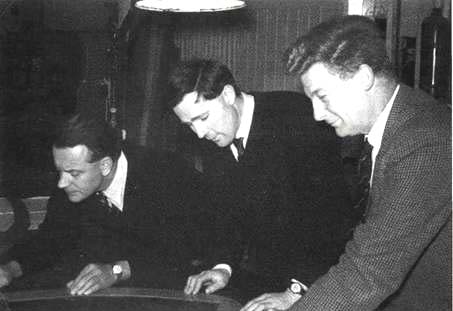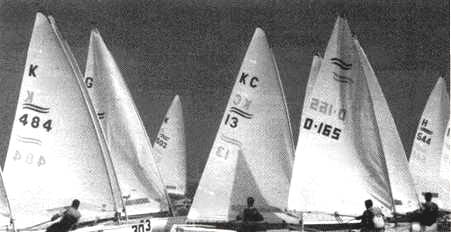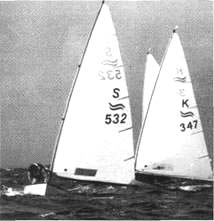Conclusion |
by Richard Hart |
|
As Peter Mohilla showed so well, the original rales were designed to show an amateur builder what to build, and in particular how to do it. The inevitable pressure on an Olympic Class made the original rales insufficient, and it was agreed that the rales should ensure that new hull should be basically the same in matters affecting speed as the original design. The rales were refined to define the shape, weight distribution and tolerances more strictly and accurately. This phase of development made a difficulty for the class in that until the middle 1960s, an ordinary Finn sailor might find that a new rale had just put his boat out of class, so far as the Finn Gold Cup was concerned.
Another aspect of the rules lies in the difficulty of application. As the rales started to develop, they ceased to be a guide to an amateur builder and became a set of constraints on a professional builder. The 1964 and 1966 Rule Books started to address the task of measurement by arranging the limiting measurements in groups to be applied 'with the hull upside down' and 'with the hull right way up'. However the rules were really intended and set out to suit the initial measurement of a new boat.
The problems of weight distribution were solved in the 1970s with the Lamboley test. This removed nearly all the 'magic' from the idea of a fast Finn: the hull could be measured and so could the distribution of mass. Sailors could concentrate on the rig.
|
Even though the Lamboley test made scantling rules redundant, and double bottoms were permitted, the class remained adamant that no alteration should be permitted from the original (supposed) shape of the Finn. It was agreed that the weight should not be reduced, the mast deck ring position remained fixed, and when aluminium masts replaced wood they were made to conform to complex rules designed to ensure that 'the rig was no further forward in the boat.' However, the 1970s was a period when the rules were effective and the class prospered because of their stability.
Such strict rules would never have allowed many of the developments that made the Finn what she is, such as bendy masts, mainsheets near the thwart, suction bailers, and so on. During the 1980s development was tending to stagnate. The Vanguard boats built in 1980-81 were still the preferred equipment of top sailors ten years later, and not a lot had happened to Needlespar masts and the sails. Regatta measurement remained a hated ordeal.
|
 |
Charles Currey, Richard Creagh-Osborne and Vernon Forster
working on the lines of the Finn Plans in the sixties. |
|
For the 1990s, the class developed a change of attitude. The Technical Committee were instructed to change the rules so as to facilitate the introduction of plastic masts. At the same time efforts were made to simplify regatta measurement.
|
 |
New simpler mast rules were introduced, the position of the deck bearing was freed, and after a period of experimentation the mast weight limit was reduced. A tight restriction (half round) on the leading edge of the centreplate was removed.
These changes were seen as beneficial and the class became receptive to other developments. By this time most boats less than 15 years old were carrying nearly 10 kg of lead correctors. The weight limit was reduced without great grief.
|
|
In the late 1990s efforts continue to make the rules more workable and to make measurement more easy and practicable, especially at regattas. To reduce the use of unmeasured equipment at local and regional regattas, requirements have been introduced for measurement before the equipment leaves the maker. A natural sequel to this requirement is to measure hulls, masts and booms to standard bearing and connection dimensions, so that in the future any mast will go into any hull with any boom. |
The measurement rules themselves are only half the story. It was found that a dedicated Chief Measurer was essential to the fair application of the rules. Ensuring that all items such as masts, booms and rudders have been measured has been a cause of difficulty: in the early days boats had only one of each!
Another problem in the early days was that different measurers sometimes made different decisions about various details. This was addressed by requiring that doubtful matters be referred to the Technical Committee. If necessary the TC conclusions were promulgated as 'Case Law' until the class submissions could be ratified by the IYRU/ISAF. Nowadays the use of 'Case Law' is diminishing because many of the doubtful points have already been incorporated into the rules.
|
 |
|
The Roles of the Technical Committee
The Technical Committee has two main duties.
Firstly it should ensure that a satisfactory standard of measurement rule observance is maintained. The instruments of this process are all those who check and measure boats, including the Chief Measurer at major regattas. The Technical Committee should see itself sometimes as a police group, but also as an independent referee to resolve possible differences between measurers and sailors.
A second main duty is to influence the development of the class by making recommendations to the class, especially at the Class Council meetings held each year. The Technical Committee then implements the requirements of the Council by drafting rule changes and submitting these for decision by our governing body, the Centreboard Boat Committee of the ISAF.
|
|